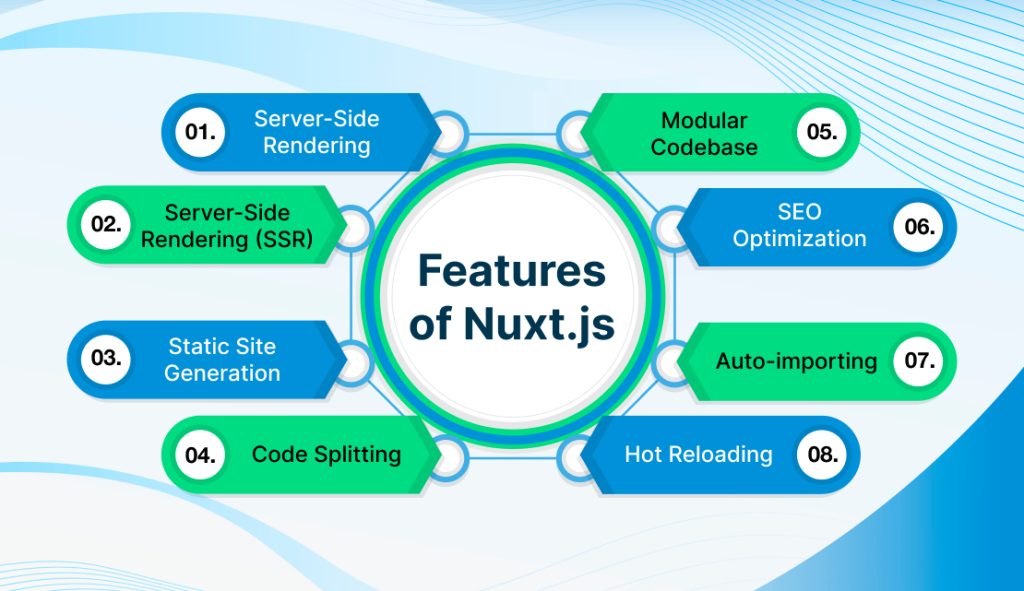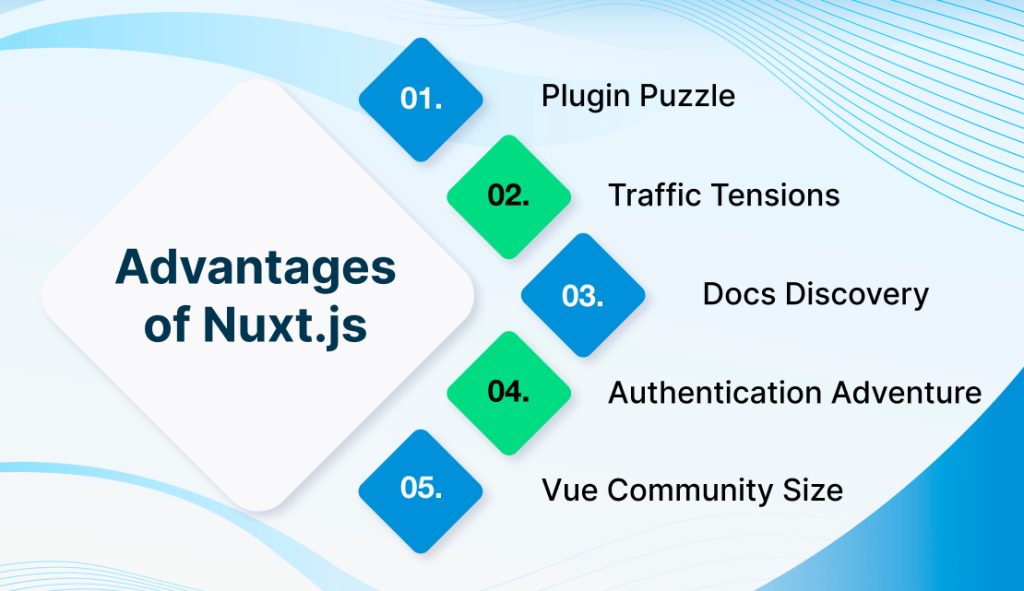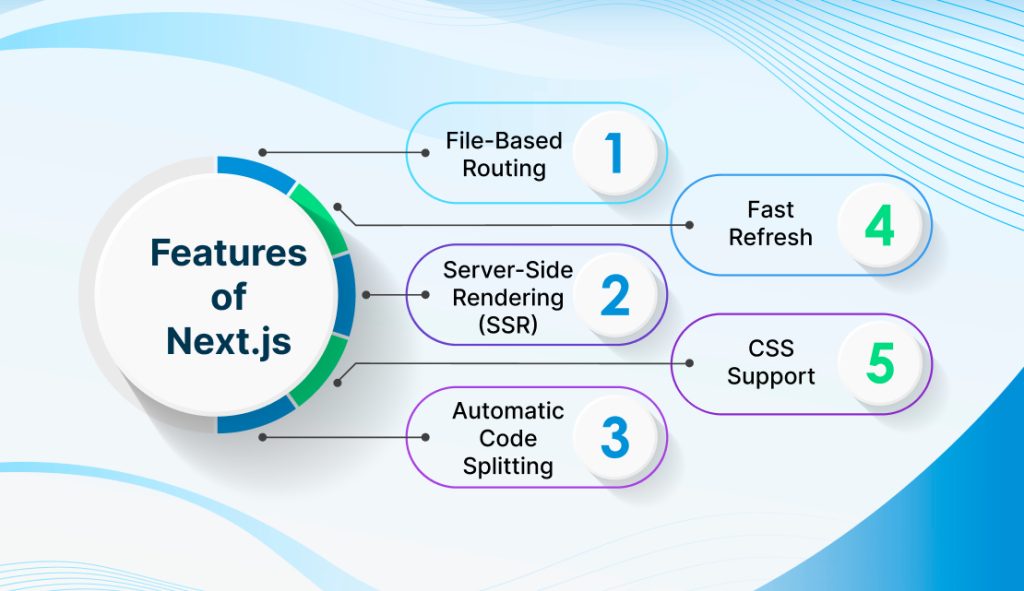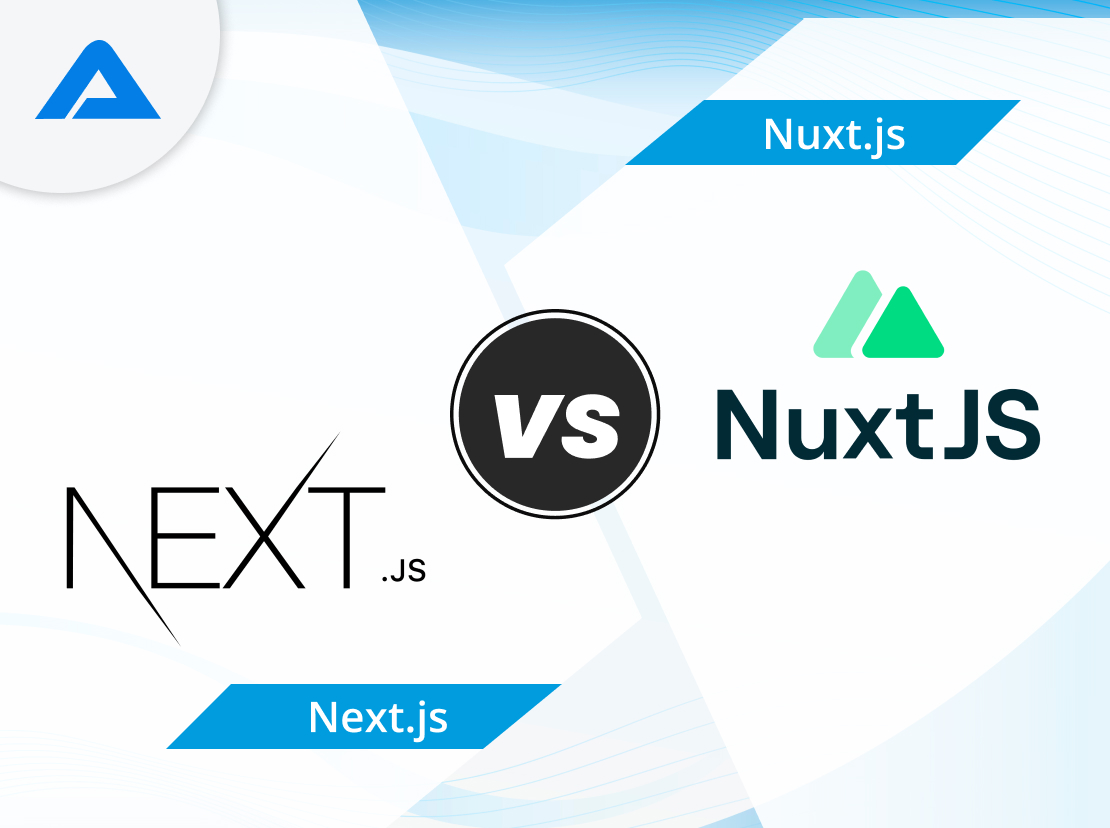Meet Nuxt and Next might sound similar, but let’s dive into how they compare!
First up, Nuxt js – it’s like the superhero for Vue developers. This powerful and user-friendly framework sets up all the configurations for creating top-notch Vue applications.
Then we have Next js, the excellent React framework by Vercel. It’s the go-to for building server-side rendered or static web application development solutions.
Beyond the similar names, these frameworks have some excellent features in common. Many developers love using them to create ready applications for the big stage!
What is Nuxt.js?
Nuxt.js is like the handy friend developers wish they always had to create excellent Vue.js applications effortlessly. Imagine this: with Nuxt.js, you can group JavaScript, HTML, and CSS on the client side, saving you time and keeping everything nice and tidy without tons of separate files.
But wait, there’s more fun stuff:
- Nuxt.js brings in Vuex to help manage the ins and outs of your application – it’s like having a personal organizer.
- It uses special SSR hooks to prepare pages on the server, so you can focus on making excellent, interactive applications without getting tangled up in complicated code jargon.
Features of Nuxt.js

Nuxt has a number of great features that extend Vue.js in ways that make it useful for building highly performant applications and websites:
1. Server-Side Rendering
Nuxt.js makes it easy to get started with server-side rendering (SSR). Vue.js is a fantastic framework where this is possible, but it requires a lot of boilerplate code to set this up. Nuxt.js eliminates this boilerplate code by making it easier to create Universal applications. Nuxt.js also provides a great example of how to start an application without any configuration.
2. Server-Side Rendering (SSR):
What it does: Nuxt makes SSR a breeze. While Vuejs development company is fantastic for SSR, it usually involves many setups. Nuxt simplifies this by making it easy to create Universal applications without drowning in boilerplate code.
Why it’s cool: You can start your app without complex configuration headaches. Nuxt sets the stage for SSR without the fuss.
3. Static Site Generation:
What it does: Nuxt isn’t just about SSR – it can also build static sites. This means you get the benefits of SSR without dealing with the server-side rendering part.
Why it’s cool: Your site becomes super efficient, and you don’t have to stress about the server side.
4. Code Splitting:
What it does: Code splitting lets you break your code into different bundles. Only load what you need on the client side, boosting your app’s performance and reducing size.
Why it’s cool: Your app becomes faster, and users only load what they need.
5. Modular Codebase:
What it does: Nuxt has a modular codebase, making it a breeze to reuse code across different projects.
Why it’s cool: Save time by using your excellent code in multiple places without the hassle.
6. SEO Optimization:
What it does: Search Engine Optimization is crucial, and Nuxt has your back. It helps manage meta tags, making your content easy for search engines to index.
Why it’s cool: Boost your website’s visibility and increase those search engine rankings!
7. Auto-importing:
What it does: Nuxt 3 automates component importing. Focus on your content, and let Nuxt 3 handle the rest. It even has a cool composable folder for importing Composition API functions automatically.
Why it’s cool: TypeScript developers rejoice – Nuxt 3 generates type definitions for you, making life easier.
8. Hot Reloading:
What it does: Preview changes without reloading your entire page. Next lets you fill individual parts of your page, saving time and making testing a breeze.
Why it’s cool: Quick changes, instant results, and a massive time-saver for debugging and testing. Nuxt makes it smooth!
Pros and cons of using Nuxt.js
Pros of Using Nuxt.js:
1. Easy Learning Curve:
Why it’s fantastic: Nuxt.js is considered a breeze to learn, especially compared to heavyweights like React or Angularjs development services. It inherits the reputation of Vue.js as one of the friendliest frameworks for newcomers.
2. Scalability Magic:
Why it’s great: Nuxt.js doesn’t break a sweat regarding scalability. Whether you dream big with a large-scale web app, Nuxt’s rendering options have your back.
3. Async Data Loading Goodness:
Why it’s cool: Nuxt.js loads asynchronous data on the server side before showing your page. Say goodbye to slow-loading content!
4. SEO Superpowers for SPAs:
Why it’s a win: Nuxt.js is your SEO sidekick for Single Page Applications (SPAs). It makes sure search engines love your content and rank it higher.
5. Automatic Code Splitting Magic:
Why it’s a plus: Nuxt.js is like a magician with code splitting. Load only what you need on the client side, making your app faster and more efficient.
6. Performance Boost with SSR:
Why it’s a thumbs-up: Nuxt.js brings server-side rendering to the table, giving your app a performance boost and quicker page loads.
7. Fast Development for MVPs:
Why it’s a time-saver: Nuxt.js lets developers speed through development, making it an ideal framework for whipping up Minimum Viable Products (MVPs) in no time.
Cons of Using Nuxt.js:
1. Missing Plugins Woes:
Why it’s a challenge: Nuxt.js might have some of the plugins you desire, like Google Maps or calendar features. It’s like having a toolbox but missing a few essential tools.
2. Server Stress with High Traffic:
Why it’s a hiccup: High app traffic might strain the server. Keeping things optimized is critical to handling the rush.
3. Documentation Blues:
Why it’s a hurdle: Some users find the documentation for Nuxt.js lacking. It’s like having a map with missing landmarks – you might need to explore more.
4. Authentication Headaches:
Why it’s a struggle: Nuxt.js authentication can be a bit of a puzzle for some developers. It might require some extra patience and problem-solving.
5. Smaller Vue Community Challenges:
Why it’s a consideration: The Vue.js community, and by extension, the Nuxt.js community, is smaller than React or Next.js. It’s like having a more minor team on a mission – things might take longer.
Advantages of Nuxt.js:

1. Plugin Puzzle:
What to know: Nuxt.js might miss some plugins you fancy, like Google Maps or calendar features. It’s akin to having a toolbox with a few key tools missing.
2. Traffic Tensions:
What to be aware of:* When your app hits the big leagues with high traffic, the server might feel slightly strained. Keeping things optimized is the secret sauce during the rush.
3. Docs Discovery:
What to expect: Navigating through Nuxt.js documentation can feel like a treasure hunt with a few missing landmarks. Be ready for a bit of exploration to unearth what you’re seeking.
4. Authentication Adventure:
What to brace for* Nuxt.js authentication can be a journey for some developers. A touch more patience and creative problem-solving might be required.
5. Vue Community Size:
What to consider: The Vue.js community, and consequently the Nuxt.js community, is smaller than the bustling crowds around React or Next.js. Picture it like having a more minor team on a mission – things might take longer.
1. Plugin Puzzle:
What to know: Nuxt.js might miss some plugins you fancy, like Google Maps or calendar features. It’s akin to having a toolbox with a few key tools missing.
2. Traffic Tensions:
What to be aware of:* When your app hits the big leagues with high traffic, the server might feel slightly strained. Keeping things optimized is the secret sauce during the rush.
3. Docs Discovery:
What to expect: Navigating through Nuxt.js documentation can feel like a treasure hunt with a few missing landmarks. Be ready for a bit of exploration to unearth what you’re seeking.
4. Authentication Adventure:
What to brace for* Nuxt.js authentication can be a journey for some developers. A touch more patience and creative problem-solving might be required.
5. Vue Community Size:
What to consider: The Vue.js community, and consequently the Nuxt.js community, is smaller than the bustling crowds around React or Next.js. Picture it like having a more minor team on a mission – things might take longer.
Disadvantages of Nuxtjs
1. Missing Toolkit:
In Plain Language: Sometimes, Nuxt.js might lack certain tools you’d like, such as Google Maps or calendar features. Imagine having a toolbox but needing a couple of essential gadgets.
2. Traffic Troubles:
In Simple Terms: When your app becomes popular and many people start using it, the server might feel overwhelmed. It’s like a road getting congested during rush hour.
3. Documentation Discovery:
In Everyday Words: Finding your way through Nuxt.js documentation can be like exploring a map with a few missing landmarks. Get ready to do some digging to find what you need.
4. Authentication Adventure:
In Casual Talk: Setting up authentication in Nuxt.js can be an adventure for some developers. It takes more patience and creativity to figure things out.
5. Community Size Consideration:
In Real Talk: The community around Vue.js, and by extension, Nuxt.js, is smaller than big players like React or Next.js. It’s like being part of a more minor team – things might take longer.
What is Next.js?
Next.js is like a superhero for web development. It’s an open-source framework that runs on React, another excellent JavaScript library. What makes Next.js unique is its ability to easily create excellent web applications with features like server-side rendering and automatic code splitting. It’s like having a trusty sidekick that simplifies complex tasks and makes your web development journey more enjoyable.
Features of Next.js

Next.js comes packed with superpowers:
1. File-Based Routing:
Why it’s cool: Next.js lets you organize your pages like files. It’s like having a neat filing cabinet for your website.
2. Server-Side Rendering (SSR):
Why it’s a win:* Next.js can render pages on the server side, loading them super fast. It’s like having a speed boost for your website.
3. Automatic Code Splitting:
Why it’s impressive: Next.js knows how to split your code into smaller pieces, loading only what’s needed. It’s like having an intelligent friend who only brings what’s necessary to the party.
4. Fast Refresh:
Why it’s handy: Next.js gives you a quick preview of changes without reloading the whole page. It’s like having a magic mirror that instantly shows your new look.
5. CSS Support:
Why it matters:* Styling is a breeze with built-in CSS support. It’s like having a fashion consultant make sure your website looks stylish.
Pros and Cons of Next.js
Pros:
1. Easy to Learn:
Why it’s excellent: Next.js is known for being beginner-friendly, making it a smooth ride into the world of web development.
2. SEO-Friendly:
Why it’s a plus: Next.js is like a tour guide for search engines, helping them navigate and rank your website effectively.
3. Fast Performance:
Why it shines: With features like server-side rendering, Next.js ensures your website performs like a champ, loading quickly for a top-notch user experience.
Cons:
1. Learning Curve for React:
Why it’s a challenge: If you need to become more familiar with React, there might be a bit of a learning curve before you can fully unleash Next.js’s potential.
2. Server Deployment Complexity:
Why it’s a hurdle: Deploying your Next.js app on a server might require some extra steps, making it more complex than simpler setups.
Advantages of Next.js for Businesses:
1. Enhanced Performance:
Business Boost:* Next.js ensures your website loads lightning fast, keeping visitors engaged and satisfied.
2. SEO Excellence:
Business Win: Improved search engine optimization services capabilities help your website rank higher, attracting more visitors and potential customers.
3. Efficient Development:
Business Time-Saver: With features like automatic code splitting and file-based routing, Next.js streamlines development, saving time and resources.
Disadvantages of Next.js
1. React Learning Curve:
What to consider: If your team still needs to become familiar with React, there might be a bit of a learning curve.
2. Server Deployment Challenges:
What to be aware of: Deploying your Next.js app on a server might require more effort than simpler setups.
Conclusion
Choosing between Next.js and Nuxt.js is like deciding between two superheroes for your web development adventure. These popular frameworks bring many cool features like server-side rendering, file-based routing, and hot module reloading, making them the go-to choices for building awesome Vue and React apps.
Now, here’s the scoop: If you’re all about the flexibility and superpowers of React, then Next.js is your hero. On the other hand, if you dig the simplicity and charm of Vue, Nuxt.js is here to save the day for you.
Regardless of your pick, both frameworks promise to help you whip up fast and dynamic web applications. It’s like having a dynamic duo at your disposal! The final decision concerns what suits your tech preferences and project requirements.
Now that you’ve got the lowdown on Next.js and Nuxt.js, you’re all set to make a savvy choice for your following frontend framework. So, gear up, superhero-style, and let the coding adventure begin!
Frequently Asked Questions
Both Next.js and Nuxt.js shine when it comes to SEO. Your choice depends on your familiarity with the framework and the specific needs of your project.
Next.js and Nuxt.js have active communities, but Next.js, part of the Reactjs development company ecosystem, may have a slightly larger community and more available plugins.
While it’s possible to switch, it can be challenging and time-consuming. Making an informed choice at the project’s beginning is recommended to avoid complications.
Both frameworks provide comprehensive documentation and tutorials, ensuring beginners have the necessary resources to get started.
Next.js is often preferred for small projects due to its simplicity and flexibility. However, Nuxt.js can also be used for smaller projects when its conventions align with your needs.
Next.js is primarily a frontend framework for building React-based web applications. It excels in handling server-side rendering and serverless API functions.
